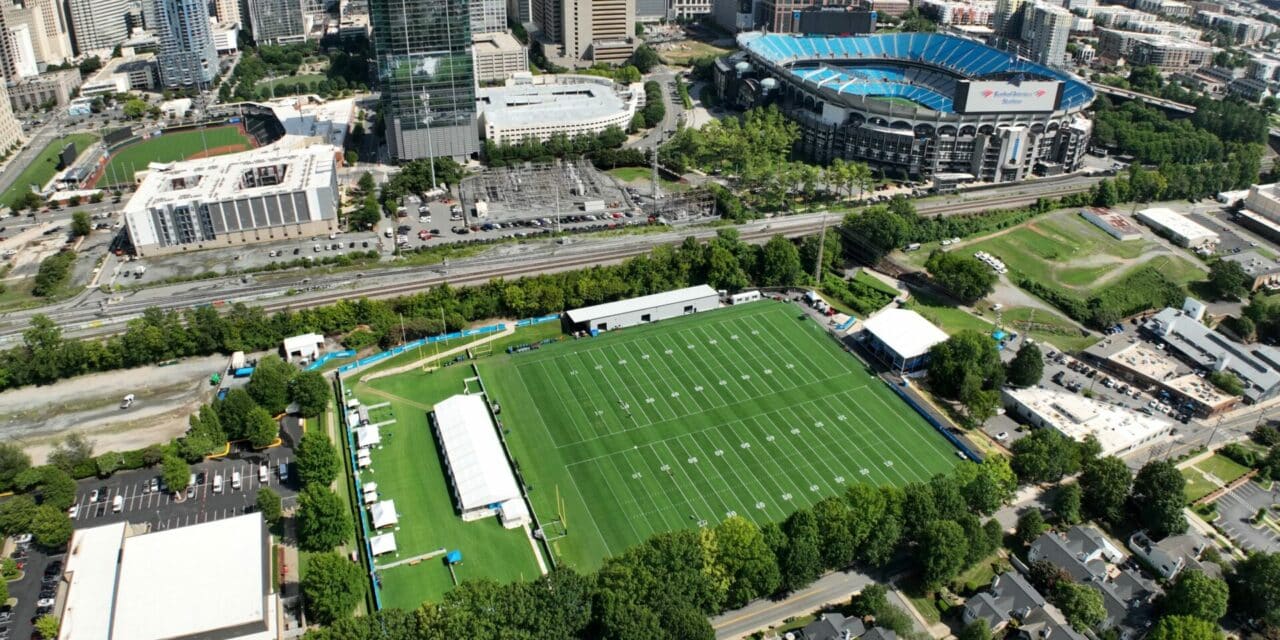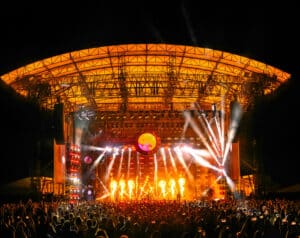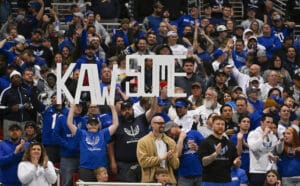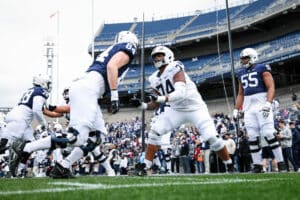PRACTICE MAKES PERFECT: An aerial view of the Carolina Panthers shows the NFL team’s practice facility setup for training camp. A new fieldhouse for indoor practice opens in 2026. (Courtesy team)
NFL team gains traction with upgraded facilities
CHARLOTTE, North Carolina — Sir Purr, the Carolina Panthers’ mascot, was perched in a tree high-fiving fans, the Purrcussion drum line kept a steady beat and the Top Cats cheerleaders displayed a sign urging folks to “show us your football is back” dance on July 24, the first day of 2024 training camp for the NFLteam.
Entering their 30th season in the NFL, the Panthers enter a new era after approving a public-private partnership with the city of Charlotte in late June to renovate Bank of America Stadium and build a new indoor practice facility next door to the 28-year-old venue that’s expected to open in 2026.
This year marks the first time the Panthers have held training camp before the public at their regular-season practice site after spending more than 25 years at Wofford College in Spartanburg, South Carolina, where original owner Jerry Richardson played college football. (The only other time the Panthers held training camp in Charlotte was in 2020 during the pandemic when it was closed to the public).
David Tepper, the NFL’s richest owner with a net worth of $21 billion, owns the Panthers now. In his seventh year at the helm, the team has gained some traction on the facility front after its $1 billion headquarters, practice facility and mixed-use project fell apart two years ago, tied to a dispute between Tepper and public officials in Rock Hill, South Carolina over financing the development.
At training camp, following a disastrous two-win 2023 season, there’s a sense of optimism in the air as the Panthers transition to a full-time practice complex that plays host to training camp. There are now two full-length grass practice fields, an expansion that took place after the old 60-yard indoor practice bubble was torn down in February.
A pair of temporary bench seating structures bookending the practice fields were installed for PSL holders and general admission seating with combined 2,000 capacity.
Team officials say the 14 open practices during training camp were “sold out” in terms of distributing free tickets, but on Day 1, grandstands were about half full during a stretch of stormy July weather in the southeast.
Fan engagement features such as face painting, a kids coloring wall, merchandise and concession tents and an inflatable structure equipped with misters, sponsored by Morris Jenkins, a longtime HVAC provider, sat on land that will be under construction next year to build the fieldhouse. Merchandise and concessions tents are part of the layout.
“We wanted to get the fan-facing stuff together in year one, and are learning all the nuances and making sure we have all those considerations; then regroup to find out what that journey looks like for next year when we’re under construction, how to replicate some of these things and where,” said Caroline Wright, the senior vice president and chief venues officer.
The Panthers, who haven’t broken down the cost to build the fieldhouse beyond the $650 million the city is providing on its end to help fund practice facility and stadium improvements, are waiting for the city’s permitting process to be completed before breaking ground, Wright said. HOK is designing both the stadium improvements and the fieldhouse, which will be equipped with an elevated viewing patio. Team officials hope to break ground late this year with the fieldhouse open in 2026.
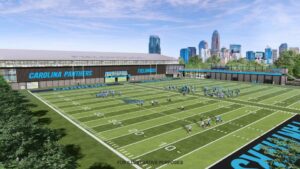
INDOOR/OUTDOOR: A rendering shows the fieldhouse and outdoor patio, part of the Carolina Panthers’ practice facility upgrades. (Twitter)
Convenience is key for the Panthers after shuttling back and forth between Charlotte and Spartanburg, a 90-minute drive, for training camp and home preseason games.
“For us, it was about building a permanent location and the most valuable asset to a football team is time,” Wright said. “When you talk about the value of time, it was definitely compressed (in the past), moving, relocating, all those things. We’ll keep the majority of programming at the stadium — nutrition, weight rooms, all that stuff. Next year will look different because we’re under construction and the third (outdoor) field will not be available, so we’ll be working on an interim solution.”
As part of the Panthers’ research process, Wright, a self-described “venues junkie,” toured other NFL practice facilities, some of which were similar to what the Panthers are developing in Charlotte. Conversely, other teams that serve as tenants at municipally-owned stadiums have their practice facilities at a separate location from where they play home games.
“So much of how we program this depends on where you are in location,” she said. “If our location was an hour down the road, you’d have a different design to what you need, because you’re not going to go back and forth. Because we’re a two-minute path away from our stadium, our collective look at how we program everything will be inclusive of the stadium and not independent.”
The Panthers haven’t forgotten South Carolina, which has historically been part of marketing the team in Charlotte, which sits about 10 miles from the Palmetto State border.
After holding a “Back Together Saturday” meet-and-greet event on July 27 at Bank of America Stadium with more than 40 former Panthers, the team’s annual fan fest set for Aug. 1 was moved to Clemson University’s Memorial Stadium. The Panthers played their first season at Clemson in 1995 while the stadium in Charlotte was under construction.
“We’ll make sure we’re ‘broadcasting’ ourselves among the two states,” Wright said. “We have a community relations team in South Carolina regularly.”
